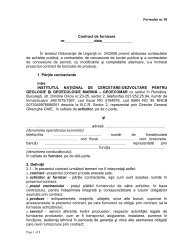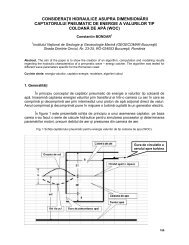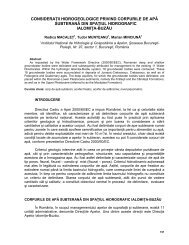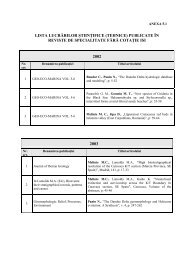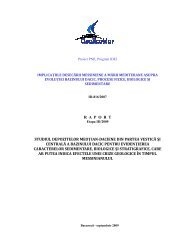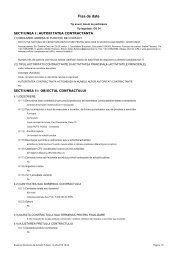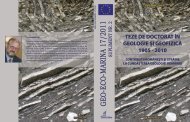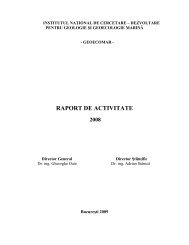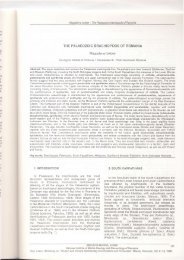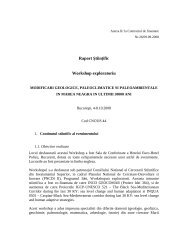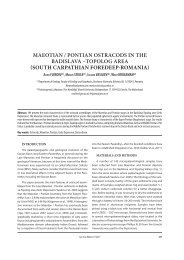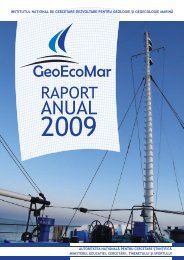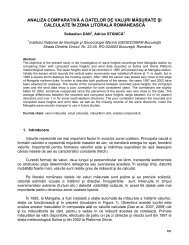DACIAN BASIN - GeoEcoMar
DACIAN BASIN - GeoEcoMar
DACIAN BASIN - GeoEcoMar
Create successful ePaper yourself
Turn your PDF publications into a flip-book with our unique Google optimized e-Paper software.
2.3. Was the Dacian Basin a lake or a sea ?<br />
Dacian Basin location and delimitation. As previously discussed in this book<br />
(Chapters 2.1.5 and 2.1.6), according to the existing paleogeographic data (Saulea<br />
et al., 1969), the Dacian Basin displayed characters of an open water basin during<br />
the Middle and Late Sarmatian (s. l.) time (Fig. 2.6). While functioning as a Middle<br />
and Late Sarmatian (s. l.) open basin, the Dacian Basin was in wide direct contact<br />
with the Euxinian Basin, exchanging water both northward and southward of the<br />
Dobrogean dry land.<br />
Surrounded on three sides by the Carpathians and Moesia, and with the Dobrogean<br />
island/peninsula to the east, the Dacian Basin was a semi-enclosed basin (Fig.<br />
2.8) during the Maeotian to Early Dacian. The basin was not completely landlocked<br />
because it maintained a permanent connection with the Euxinian Basin and also<br />
had episodic connections with the Pannonian Basin (Figs. 2.7 and 2.8).<br />
Salinity of the Dacian Basin water body. As a consequence of isolation and internal<br />
division into distinct sub-basins, brackish conditions established throughout<br />
the Paratethys realm, starting from the Badenian (Rögl, 1999). Following the evolution<br />
of the Paratethys domain, the Dacian Basin was brackish since it has been<br />
formed. Based on the fauna in the western part of the Dacian Basin (the Valea Morii<br />
profile), Marinescu (1978) concludes that the Sarmatian water had a salinity of 16 –<br />
18 ‰. Pană (1966) and Saulea (in Saulea et al., 1969) reached similar results in the<br />
northern part of the Dacian Basin. Papaianopol (in Papaianopol et al., 1995) indicates<br />
that the Sarmatian fauna from the central part of the basin (Buleta, Râmnicu<br />
Vâlcea area) suggest water salinity of approximately 14 ‰.<br />
Papaianopol et al. (1995) point out the oscillating character of the water salinity<br />
during the Maeotian time. A low salinity level (5 – 10 ‰, Marinescu, 1978) is<br />
recorded in the lowermost interval, rich in Congeria fossils. The upper part of the<br />
Early Maeotian (Oltenian), with Dosinia fauna, represents a high salinity episode<br />
(approximately 18 ‰, Marinescu, 1978). Brackish, but mostly fresh-water fauna occur<br />
in the Late Maeotian (Moldavian) deposits.<br />
During the Pontian, the Dacian Basin water salinity was 7 – 8‰ (the level of<br />
Congeria rhomboidea of the Bengeşti fauna) (Papaianopol et al., 1995). The salinity<br />
value dropped to 5 – 6 ‰ and occasionally reached nearly 3 ‰ during the deltaic<br />
Early Dacian.<br />
The general picture portrayed by the data presented above is that the Dacian<br />
Basin water salinity evolved from a high-brackish value (18 ‰) at the beginning of<br />
the basin history to fresh-water at the terminal stage of the Dacian Basin existence<br />
(since Middle Dacian time). The salinity values decreased and oscillated during the<br />
Maeotian and continued to decrease during the Pontian.<br />
63



